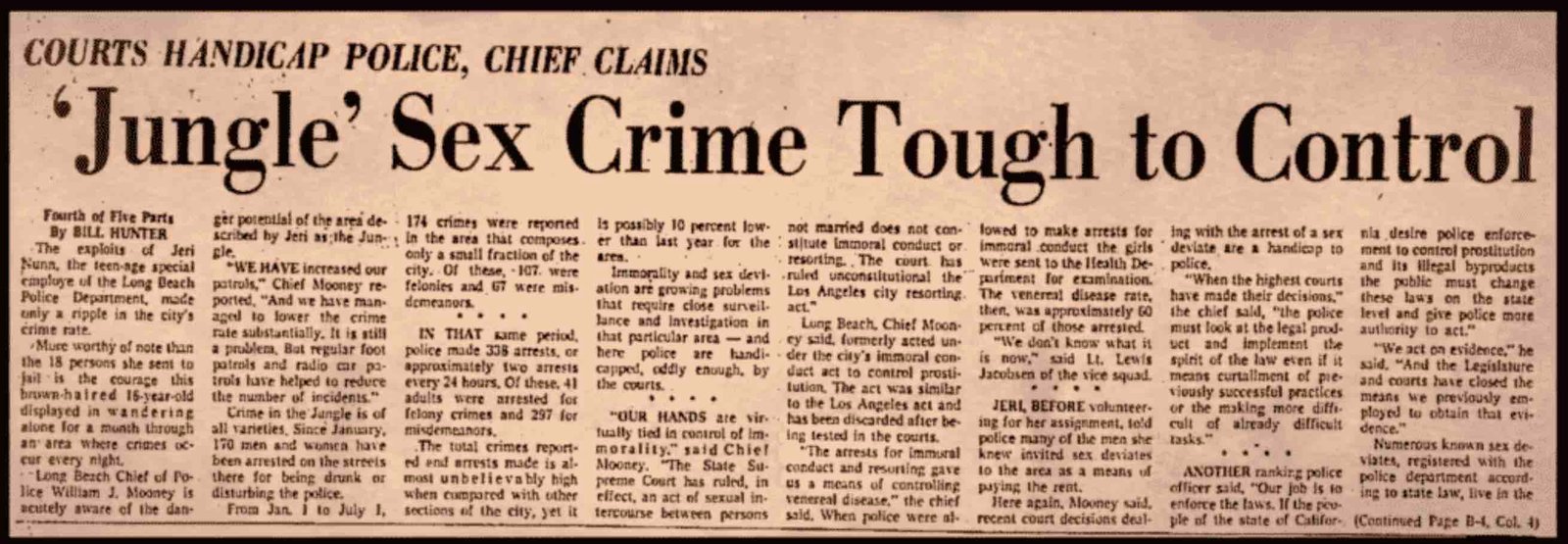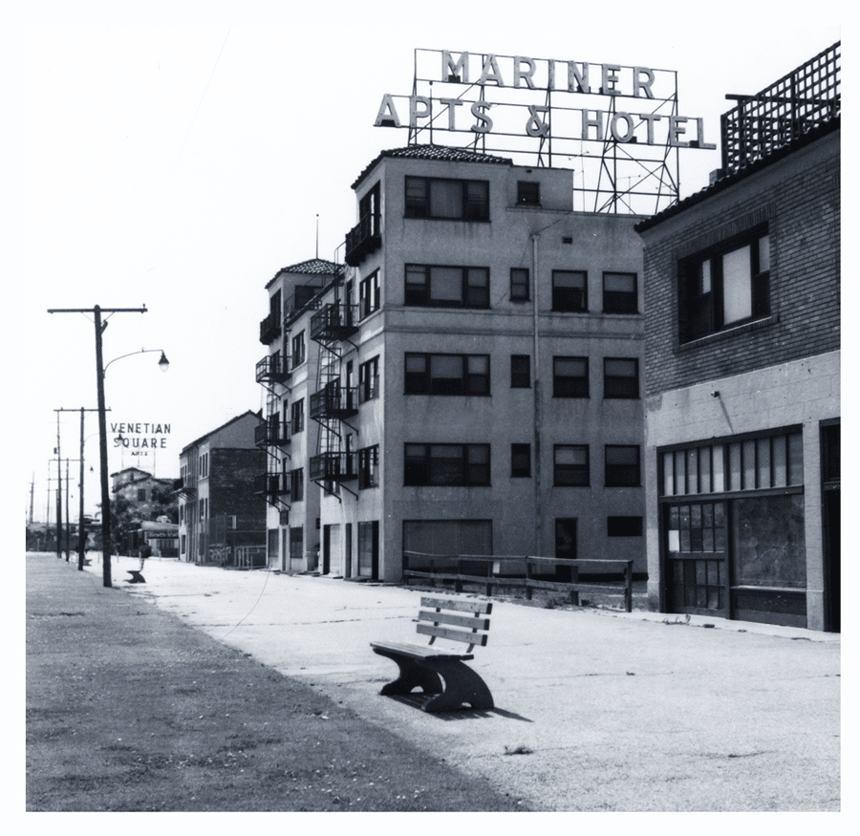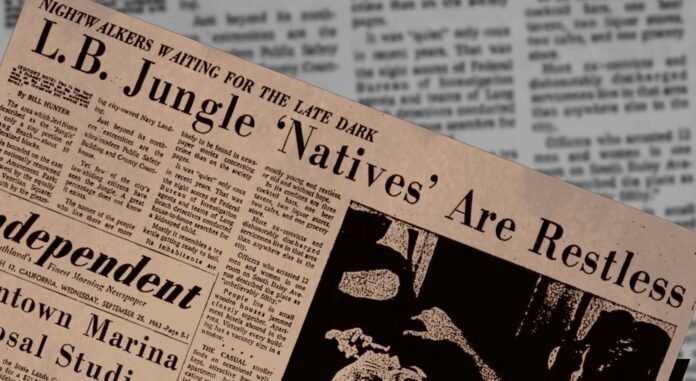My ongoing series, Long Beach Lost, was launched to examine buildings, spaces, and cultural happenings that have largely been erased, including the forgotten tales attached to existing places and things. This is not a preservationist series but rather a historical series that will help keep a record of our architectural, cultural, and spatial history.
Editor’s note: This series first appeared on Longbeachize in 2017 and 2018; some articles have been republished, updated, and/or altered.
Want to read previous Long Beach Lost articles? Click here for the full archive.
In 1963, 18-year-old self-appointed savior-of-the-neighborhood Jeri Nunn had annulled her marriage, lost an unborn child, and had a contract on her head: $500 for the person who would assassinate her.
Nunn meandered the streets of The Jungle, roughly south of Ocean Boulevard and west of Magnolia Avenue in Downtown toward the river’s edge. During the night, during the day, Nunn was searching for clues that would fulfill her voluntary mission of conning cons into her giving her information that would halt the spread of narcotics that she felt she “had to do something about.”.
“‘Born to Lose’ is the way to describe many Long Beach ‘Jungle’ area inhabitants… Young man’s tattoos include the word LOVE on the knuckles of his left hand. (On his right hand is the word HATE.) He wears an ornate ring on his left ear. His girlfriend’s hair is bleached and stringy. Her face is marred by long scratches from a recent fight.” – The Independent Press-Telegram, 1963
What was that, exactly? She volunteered as an informant for the LBPD, ultimately leading to the arrest of 14 men and four women—and once her disguise was uncovered during the trial of one of those arrested, her life was perpetually threatened.
Her story was part of Long Beach’s head crime reporter Bill Hunter’s five-part series of articles on The Jungle for the Independent Press-Telegram. (In 1952, The Independent and The Press-Telegram, each separate papers, merged, with the former being the morning edition and the latter being the evening edition.) He described it as a place of “immorality and sexual deviation” that was “beyond the control” of the Long Beach Police Department.

According to Long Beach resident Jo Montgomery—whose great aunt lived in The Jungle and she would visit every summer before she moved from San Francisco to Long Beach—it was common knowledge that the neighborhood was anything but savory.
“There was an opium den in the back of one of the bars—can’t remember the name—but found out about that when Grandma Pearl came down from San Francisco to visit after I moved here,” Montgomery noted.
This isn’t the only tale surrounding salacious behavior in The Jungle’s various saloons, bars, and diners: The then-well-known Neptune’s Lounge, home to The Tops Cafe, had waitresses who were allegedly encouraged to wear as little as possible while serving, including some going outright topless or bottomless to garner extra tips (or possible arrest and other tomfoolery).
Despite the judgmental and moralistic overtones—quotes from officers and officials throughout Hunter’s series consistently demonized the poor folks who lived there, despite the fact that it was the only place they could afford—it is actually easy to understand how such a small place could get out of control.

In its tiny plot of land, what is now known as the minuscule patch of grass dubbed Santa Cruz Park and, before the Jungle, a picturesque resort-like space, there were three cocktail bars, two liquor stores, and a beer tavern. It was home to “more ex-convicts and dishonorably discharged servicemen than any other area in the city.”
In one of Hunter’s, the caption to the cover story’s photo read: “’Born to Lose’ is the way to describe many Long Beach ‘Jungle’ area inhabitants like the pair shown in this unposed photo. Young man’s tattoos include the word LOVE on the knuckles of his left hand. (On his right hand is the word HATE.) He wears an ornate ring on his left ear. His girlfriend’s hair is bleached and stringy. Her face is marred by long scratches from a recent fight.”
Hunter’s series of articles prompted an editor from the paper, noting that it was a place where “poverty, dope addiction, sexual misbehaviors, violence, and petty crime” flourish.
It was the home of the camp of ladies known as the Hamburger Queens—named so because their sexual favors were offered for the price of a burger—where they stood in the only heels they could afford, roaming The Jungle’s interiors and backdoors before takin’ a Naval officer to a place where they could more appropriately conduct business. (Or spread infections: the STI rate was 115 times higher than any other area of the city, a testament to both the hard work of the Queens and their ability to somehow stay alive.)

The Independent, Press-Telegram didn’t mince words in its editorial, not stopping from outright damning the neighborhood:
It’s not the worst place in the world but it does require special police effort just to keep the place from exploding. It is a center of venereal disease. Its denizens push narcotics and dangerous drugs. It is a cancer, though not a large one, in an otherwise healthy city.
Readers [are asking], “What can be done about it?”
There is only one answer: surgery. The Jungle exists because it provides housing suitable to the pocketbooks of its desperate residents. If the housing is removed, they will go elsewhere.
Where will they go? Most of them will seek comparable housing. It is to be hoped that they can’t find it in Long Beach. The decent people—there are decent people in The Jungle—will find homes in better neighborhoods.
In 1963 alone, the Long Beach Police Department arrested at least two people every day in The Jungle, with some 200-plus crimes occurring in the first half of the year alone.

This wasn’t always the case with The Jungle (or the eventual downtrodden Pike). It was, initially, a resort space where folks came to enjoy the sand and sun. Post-World War II, with the influx of sailors due to the Navy presence in Downtown, things began to change, with sailors seeking thrills to get their rocks off.
By 1961, when Long Beach’s Redevelopment Agency was formed, its first order of business, as journalist Matt Cohn noted, was The Jungle.
Soon, articles began to sing praises of “the development on West Beach” that would be coming—and they were eventually right. Now, the area is home to precisely what Hunter and others were hoping for: Gleaming office towers, maintained properties and an almost complete lack of crime if not an equal amount of sterility and banality.
But one can’t help but give props and recognition to the down-and-outs, the dirty tricksters, the hookers and their patrons, the tatted hot messes that were so virulent and dedicated to the many pleasures of the underbelly that they created their very own wild, unpredictable jungle.



Great story, I was 4or5 when my family lived in one of those apartments pictured. My brother was 14or15, sis 11or12. Mom, when speaking of our short time living there described it as skid row. Thinking the year was about 1958. Wishing I could have discussed this time of our life with siblings, but sis has passed and brother is effected with Alzheimer’s. I can remember venturing to the kid section of the Pike till an adult told me to scram kid. Also remembered venturing with brother and sis to the nearby trolly car graveyard and climbing in and out of trolly’s. Mom and dad obviously had fallen on hard financial times. Things got better we eventually lived about 3 miles up river to West Long Beach where we were raised. Again thank you for the enlightening article.